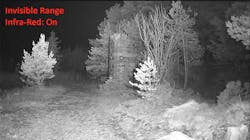This article originally appeared in the September 2023 issue of Security Business magazine. When sharing, don’t forget to mention Security Business magazine on LinkedIn and @SecBusinessMag on Twitter.
In 2018, the U.S. National Defense Strategy speculated that artificial intelligence would, in the distant future, “ensure the United States will be able to fight and win the wars.” In 2023, Congress codified that idea in its annual defense policy bill, folding AI into several new activities aimed at strengthening the nation’s cyber defenses and physical security efforts.
Suffice to say, investment in AI is now a national security interest. That said, AI is gaining traction in the private security sector as well, from small businesses to enterprise customers.
As camera resolution has improved, integrators have begun to take advantage of a wide gambit of AI applications, from basic people counting for business intelligence to deep learning-based people and object recognition functionalities. As AI-empowered video analytics continue to explode, the only thing that could possibly hold them back is the reliability of the video surveillance technologies they rely on.
Challenges to Video Analytics Performance
Advanced video analytics, which combine machine learning and high-definition camera technology, can track objects, identify intruders, collect traffic information, monitor machinery conditions, inform deterrent procedures and even autonomously mitigate threats in real time; however, video analytics can only perform at their best when ingesting high-quality images.
Video analytics algorithms analyze the pixels that compose an image captured by the camera. In essence, each pixel is a data point. Algorithms typically search for certain defined changes in pixels within a specific zone of an image within a certain timeframe to determine whether an unauthorized individual has entered a certain area, a car with a certain license has driven through an intersection, or an object has been left unattended for too long.
When it comes to maximizing image quality around the clock, one of the greatest challenges for all security cameras is capturing usable images in low-light scenarios.
It is impossible for video analytics to perform properly without sufficient image quality. Even the most powerful processor and the most sophisticated algorithms will still produce erroneous findings when analyzing poor quality images.
Without an external lighting source, even high-definition cameras can only capture dark, grainy footage. Not only is this kind of video useless to security personnel, but it is similarly rendered ineffective for analytics. For integrators dealing with this issue, external illuminators may be the answer, as they ensure cameras can collect high-quality footage that is optimized for the performance of AI.
Just like a human eye needs some sort of light to “see,” video surveillance technology depends on visible light to produce quality images. Integrating external illuminators into a security solution can optimize camera performance exponentially, expanding a camera’s video capture and coverage abilities and ensuring the operation of video analytics in daytime and night.
Opting for an external illuminator also allows system integrators to select a device that matches the exact emission range of a camera’s field of view (FOV), resulting in an evenly lit visual field to meet each deployment’s individual needs and optimized performance of video analytics.
IR vs. White Light
When it comes to choosing an external illumination device there are two options. While IR illuminators optimize camera performance by expanding a camera’s video capture and coverage abilities, if a customer needs to implement full-color video analytics for identification purposes, such as for facial, object and license plate recognition, white light illuminators are an integrator’s best bet.
Choosing which device to deploy often comes down to the task the end-user is looking to video analytics to perform; however, at the end of the day, both IR and white light external illuminators optimize a surveillance camera’s detection capabilities in low-light scenarios, which is fundamental to the performance of analytics.
IR Illuminators emit electromagnetic radiation (EMR) with wavelengths longer than those of visible light, making it invisible to the human eye and perfect for covert surveillance operations. While a standard day/night camera with built-in IR LEDs has a realistic detection range of about 75 feet, mounting an independent, long-range IR illuminator next to a video camera can increase the camera’s detection range to more than 900 feet.
When cameras need to be able to detect potential threats over long distances, without alerting potential intruders, IR illuminators are the perfect tool for the job.
IR illumination typically ranges from 700 nanometers to 1,000 nanometers in the electromagnetic spectrum, allowing cameras integrated alongside them to produce images even in low-light scenarios and even in darkness, delivering more precise alerts for intrusion, loitering, object detection and other video analytics functionalities.
White Light Illuminators installed alongside AI-powered surveillance cameras enable enhanced video image clarity. Integrators can choose from a variety of white light emission ranges to accommodate a camera lens’ particular field-of-view (FOV) and deliver an evenly lit visual field for video analytics applications at every distance.
While some cameras come equipped with their own lights, built-in illuminators typically only cover a maximum 30-degree FOV, even though a camera’s widest FOV is 90 degrees. This not only creates “hot spots” in the middle of the camera view, but it can also “white out” the rest of the image.
White lights also enhance video capture for operations where full color video is essential, whereas sensors using IR illumination or thermal technology can only provide black and white images. Because of their low running cost and comparably longer lifespan, white light illuminators also save end-users thousands of dollars in annual energy costs.

